Updated: AOpen MiniPC – Imitation is the Sincerest Form of Flattery
by Jarred Walton on March 3, 2006 12:05 AM EST- Posted in
- Systems
Installation and Setup
The installation and setup process for the MiniPC is really a tale of two extremes. AOpen shipped us a pre-built unit, so all I had to do was plug it in, connect an appropriate keyboard and mouse, and it was ready for use. That's how every one of these systems should be sold, because frankly, stuffing the necessary parts into a case this small is going to be a difficult task for most people. Popping open the unit shows just how much room you have to work with, and we would much rather leave the task of putting the computer together to the people on the assembly line. If you have really large hands, if could be difficult, though really having the right tools is the most important part of working with the case.
Four screws underneath the non-slip pad secure the case, and removing them is pretty simple. Once that's done, opening the case still requires some effort, as the top and bottom snap together. After you (carefully) pry it open, you can see the internals, which are packed with all of the required parts. The process of pulling the top and bottom apart is definitely not easy, and given the presence of four screws to hold the two halves together, we would prefer to use less force. All the little metal "teeth" around the sides appear to add a lot of pressure so that even without the screws the top and bottom are in no danger of separating. The metal prongs can also scratch the sides if you're not careful when pulling the case apart or putting it back together.
The motherboard has a single DDR2 SO-DIMM slot, a Mini-PCI slot that is filled with a wireless networking device in some configurations (our unit didn't have WiFi), and a heat sink and fan unit that covers both the CPU and the chipset. It would have been nice to get a second SO-DIMM slot for memory expansion, and most laptops have memory access panels underneath a small hatch to make RAM upgrades easy and quick. That's something for Aopen or their competitors to consider for future designs.
While the HSF is quite small and would certainly be inadequate for cooling higher power CPUs, the 22W TDP Pentium M does perfectly well, and the case under full load was only slightly warm - just like a typical laptop.
The top of the unit has a plastic cage that holds the 2.5" HDD and the slim optical drive. Removing four more screws and a bit more prying gets that out of the way, at which point you can install the HDD and optical drive. Note that the optical drive is a standard laptop form factor, but a slot-loader drive is required. AOpen makes such drives in either a CD-RW/DVD-ROM combo unit or a standard DVD+/-RW drive. A proprietary PCB converts the IDE interface into a connection that slots into the motherboard (which incidentally also helps to hold the top and bottom of the case together). The card then plugs into the connections on the optical drive and HDD - think of it as a solid, compact replacement for the typical ribbon cable.
In the above images, you can also see that there is a built-in speaker that functions as a mono audio output. It isn't very loud and the quality is what you would expect from the size, not to mention that it's concealed behind a metal cover. It will be sufficient for hearing the Windows sound events and listening to audio files where high fidelity isn't a requirement - basically enough for a business environment.
The installation and setup process for the MiniPC is really a tale of two extremes. AOpen shipped us a pre-built unit, so all I had to do was plug it in, connect an appropriate keyboard and mouse, and it was ready for use. That's how every one of these systems should be sold, because frankly, stuffing the necessary parts into a case this small is going to be a difficult task for most people. Popping open the unit shows just how much room you have to work with, and we would much rather leave the task of putting the computer together to the people on the assembly line. If you have really large hands, if could be difficult, though really having the right tools is the most important part of working with the case.
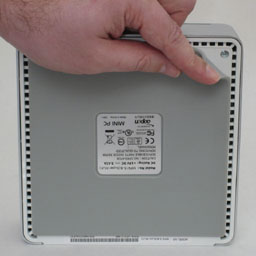 |
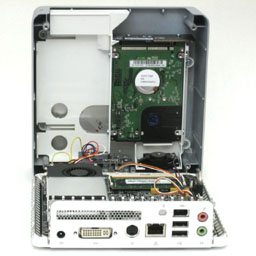 |
| Click on images to enlarge. | |
Four screws underneath the non-slip pad secure the case, and removing them is pretty simple. Once that's done, opening the case still requires some effort, as the top and bottom snap together. After you (carefully) pry it open, you can see the internals, which are packed with all of the required parts. The process of pulling the top and bottom apart is definitely not easy, and given the presence of four screws to hold the two halves together, we would prefer to use less force. All the little metal "teeth" around the sides appear to add a lot of pressure so that even without the screws the top and bottom are in no danger of separating. The metal prongs can also scratch the sides if you're not careful when pulling the case apart or putting it back together.
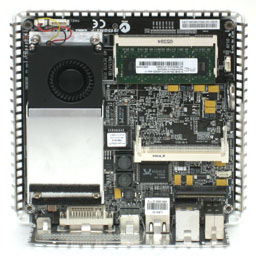 |
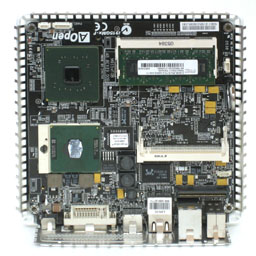 |
| Click on images to enlarge. | |
The motherboard has a single DDR2 SO-DIMM slot, a Mini-PCI slot that is filled with a wireless networking device in some configurations (our unit didn't have WiFi), and a heat sink and fan unit that covers both the CPU and the chipset. It would have been nice to get a second SO-DIMM slot for memory expansion, and most laptops have memory access panels underneath a small hatch to make RAM upgrades easy and quick. That's something for Aopen or their competitors to consider for future designs.
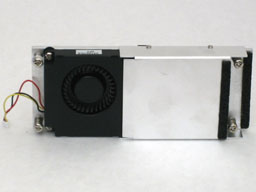 |
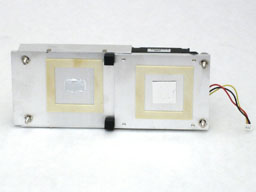 |
| Click on images to enlarge. | |
While the HSF is quite small and would certainly be inadequate for cooling higher power CPUs, the 22W TDP Pentium M does perfectly well, and the case under full load was only slightly warm - just like a typical laptop.
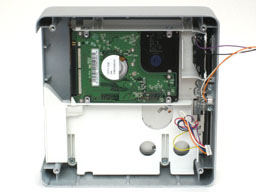 |
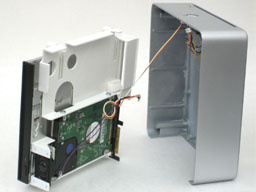 |
| Click on images to enlarge. | |
The top of the unit has a plastic cage that holds the 2.5" HDD and the slim optical drive. Removing four more screws and a bit more prying gets that out of the way, at which point you can install the HDD and optical drive. Note that the optical drive is a standard laptop form factor, but a slot-loader drive is required. AOpen makes such drives in either a CD-RW/DVD-ROM combo unit or a standard DVD+/-RW drive. A proprietary PCB converts the IDE interface into a connection that slots into the motherboard (which incidentally also helps to hold the top and bottom of the case together). The card then plugs into the connections on the optical drive and HDD - think of it as a solid, compact replacement for the typical ribbon cable.
In the above images, you can also see that there is a built-in speaker that functions as a mono audio output. It isn't very loud and the quality is what you would expect from the size, not to mention that it's concealed behind a metal cover. It will be sufficient for hearing the Windows sound events and listening to audio files where high fidelity isn't a requirement - basically enough for a business environment.










54 Comments
View All Comments
plinden - Friday, March 3, 2006 - link
Yeah, when are we getting the ability to edit our posts?siliconthoughts - Friday, March 3, 2006 - link
When a genuine mac mini costs less, is more upgradeable (dual core, 2 DDR slots, digital audio, WiFi, Bluetooth, 4 USB ports, faster graphics) comes with a nifty secure OS and includes a whole suite of apps, why would anyone buy this? XP just isn't that great that I'd spend a $300 premium for it on an inferior box.Googer - Friday, March 3, 2006 - link
These are nice, but It is my suspicion that a Turon in an Mini PC would be the faster choice.NegativeEntropy - Saturday, March 4, 2006 - link
Agreed -- a Turion "version" would be interesting. That said, I think this statement from the review could use a bit of modifying:"...if you really want low power, you can go with one of the Pentium M platforms. End of discussion. "Tech Report recently found that the Turion can compete pretty well with the PM on power consumption http://techreport.com/reviews/2006q1/pentiumm-vs-t...">http://techreport.com/reviews/2006q1/pentiumm-vs-t...
JarredWalton - Saturday, March 4, 2006 - link
This isn't meant as a far-reaching statement. What I'm talking about is small form factors, or systems that will compete with the MiniPC. Turion support on socket 754 platforms is lacking, meaning that there are boards that support it but there are definitely boards that won't support it. Most of the socket 754 small form factors are pretty old, so I don't know how many of them would support Turion.The article at Tech Report is interesting, but idle power draw is only half of the question. 94 W at full load really isn't that much better than the rest of the Athlon 64 line. I mean, the HP DX5150 with an old ClawHammer core running at 2.4 GHz is only about 20 W higher. If you were to use a 90 nm Athlon 64, that would cut off 10 W or so right there.
Basically, the Athlon 64 design is really good, and it doesn't require all that much power. However, it still can't really compete with the Pentium M. when you shift to laptops, the whole system probably doesn't consume more than 45 W, so 20 W more for the processor is a major deal. Using desktop systems to try and determine laptop suitability is definitely not the best way to go about it. Ideally, you would want identical laptops, with the only difference being motherboard, chipset, and memory. But that's a story for another day.
Googer - Friday, March 3, 2006 - link
I would love to see this Aopen MINI PC rebench marked with a Pentium M 733 or 753 Ultra Low Voltage Processor that has a Maximum of 5W TDP! I would love to see it compaired against the higher 27W TDP Pentium M 740 in both Power Consumtion and Application benchmarks.I bet that at full load the power usage on full load will drop from 38W (with 740) down to 16w and even lower at IDLE! (10W maybe?) With a processor like that this would be the perfect pc for those guys who like to intergrate computers with their cars. Bye bye VIA C3! (C3 Will have http://www.metku.net/index.html?sect=view&n=1&...">other uses though)
JarredWalton - Friday, March 3, 2006 - link
Actually, with the HDD and other components, the system is probably using around 18W for the system and 7 to 20W for the CPU. It might even be 20-22W for the system. Still, 38W at maximum load (i.e. HDD activity along with 100% CPU) is hardly going to tax a car, I don't think. (But I'm not a car A/V guy, so maybe I'm wrong.)michael2k - Friday, March 3, 2006 - link
You would think, with AOpen's resources, that the AOpen MiniPC would be cheaper than the more powerful and featureful Mac mini.What is AOpen doing that is making it more expensive? It's got an older chipset, slower CPU, less USB ports, no rewritable optical drive, no bluetooth, and no wireless networking.
It's an odd day when buying a Mac is cheaper AND more powerful.
Questar - Friday, March 3, 2006 - link
AOpen isn't isn't a computer manufacturer, they are a board maker. What could they do to bring down the price of a system?jconan - Friday, March 3, 2006 - link
It's the economy of scale! Apple definitely has this contract manufacturing capacity considering its hardware/software business as well as its distribution channels. AOpen is just a manufacturing firm and is not in the software business to install an in house OS and plus it doesn't have sufficient sales offices out in the distribution side to push its wares. They have to rely on major OEMs to buy in bulk quantity to leverage prices with them.